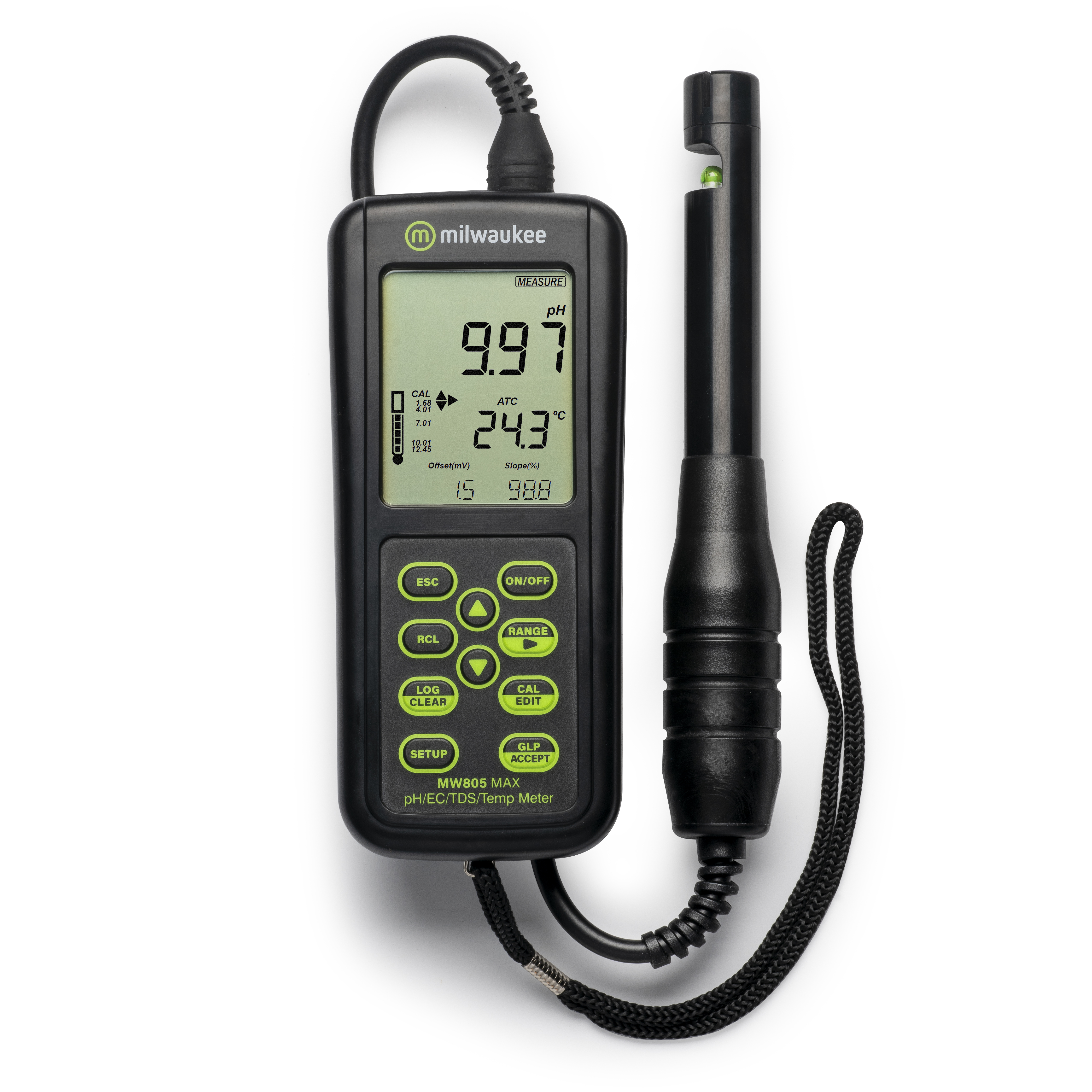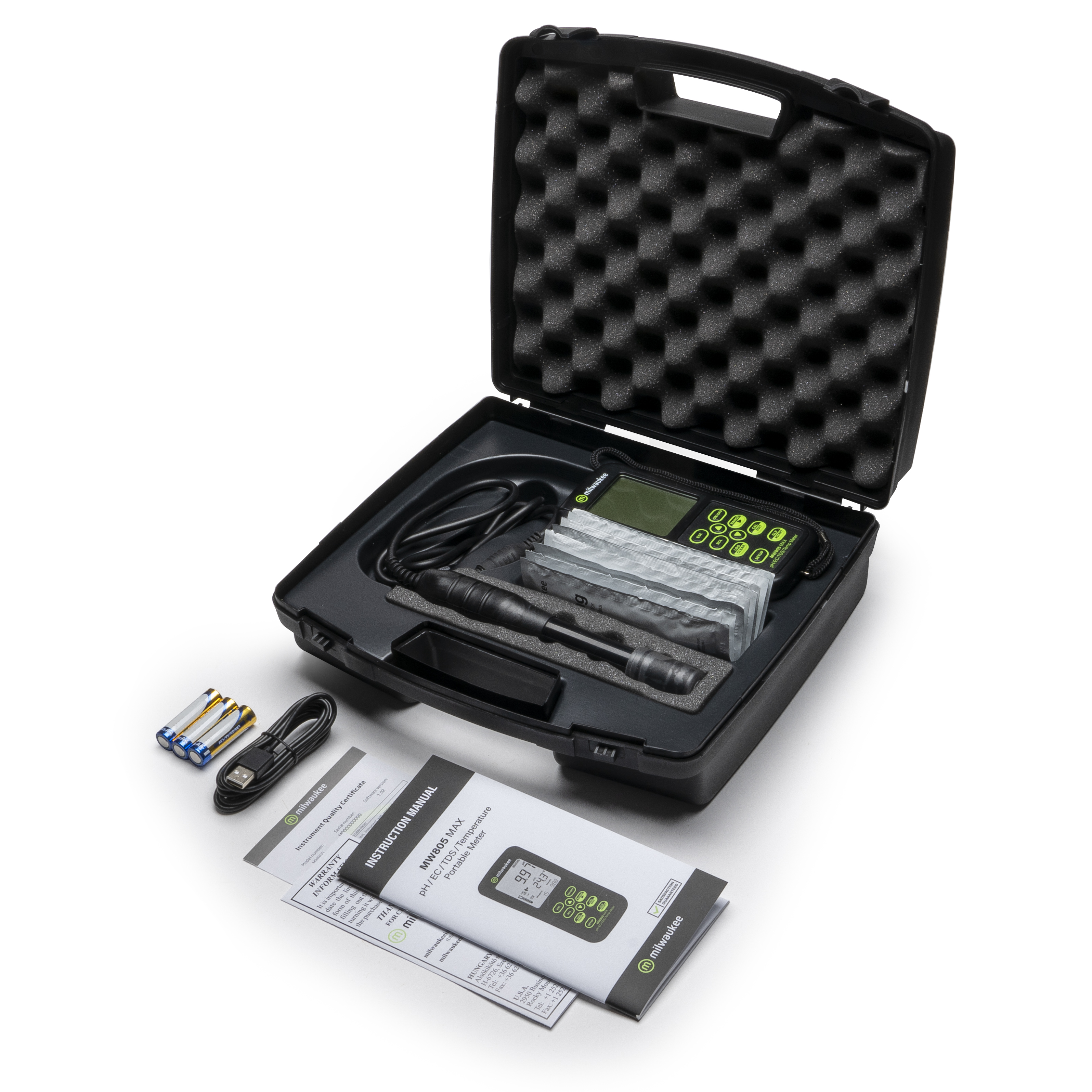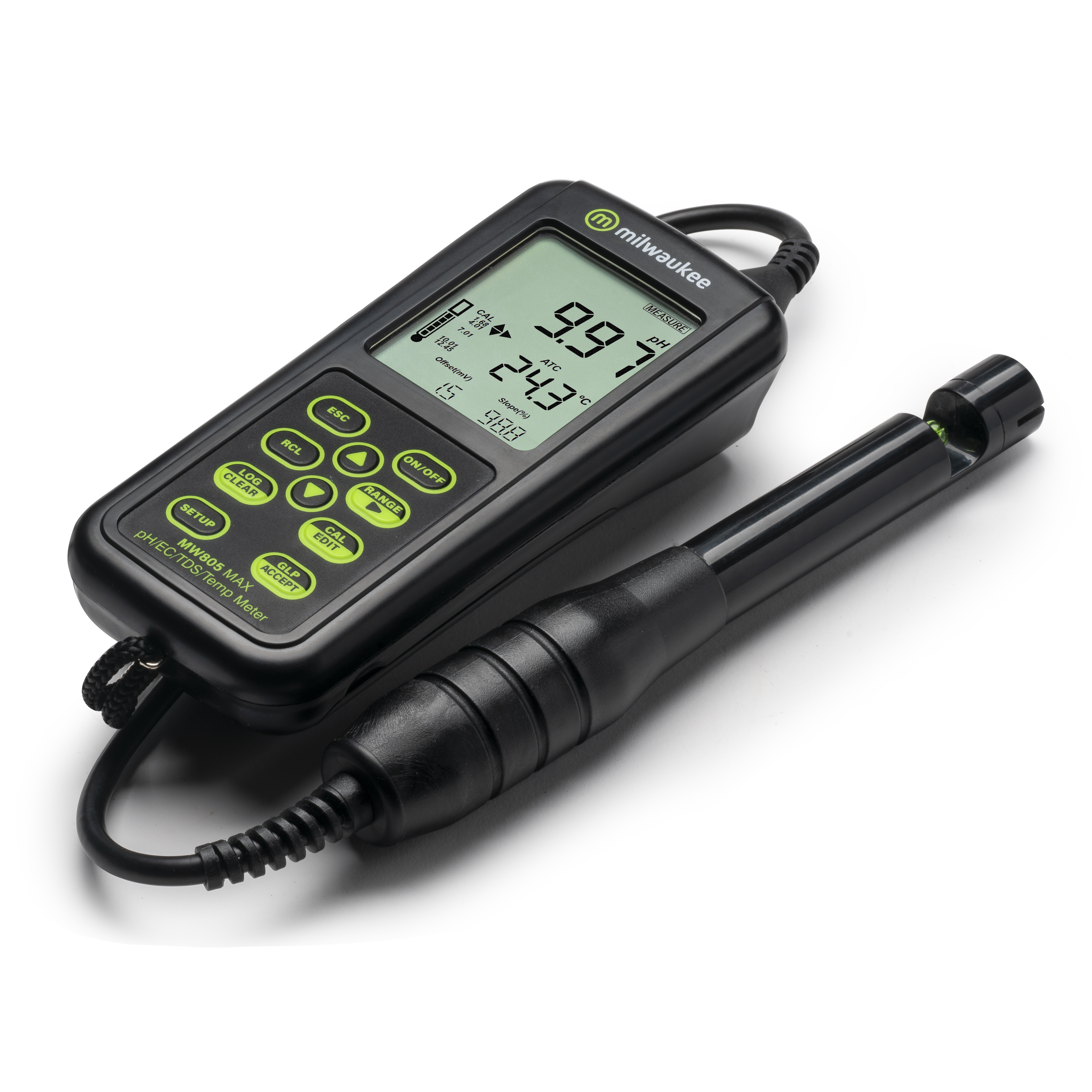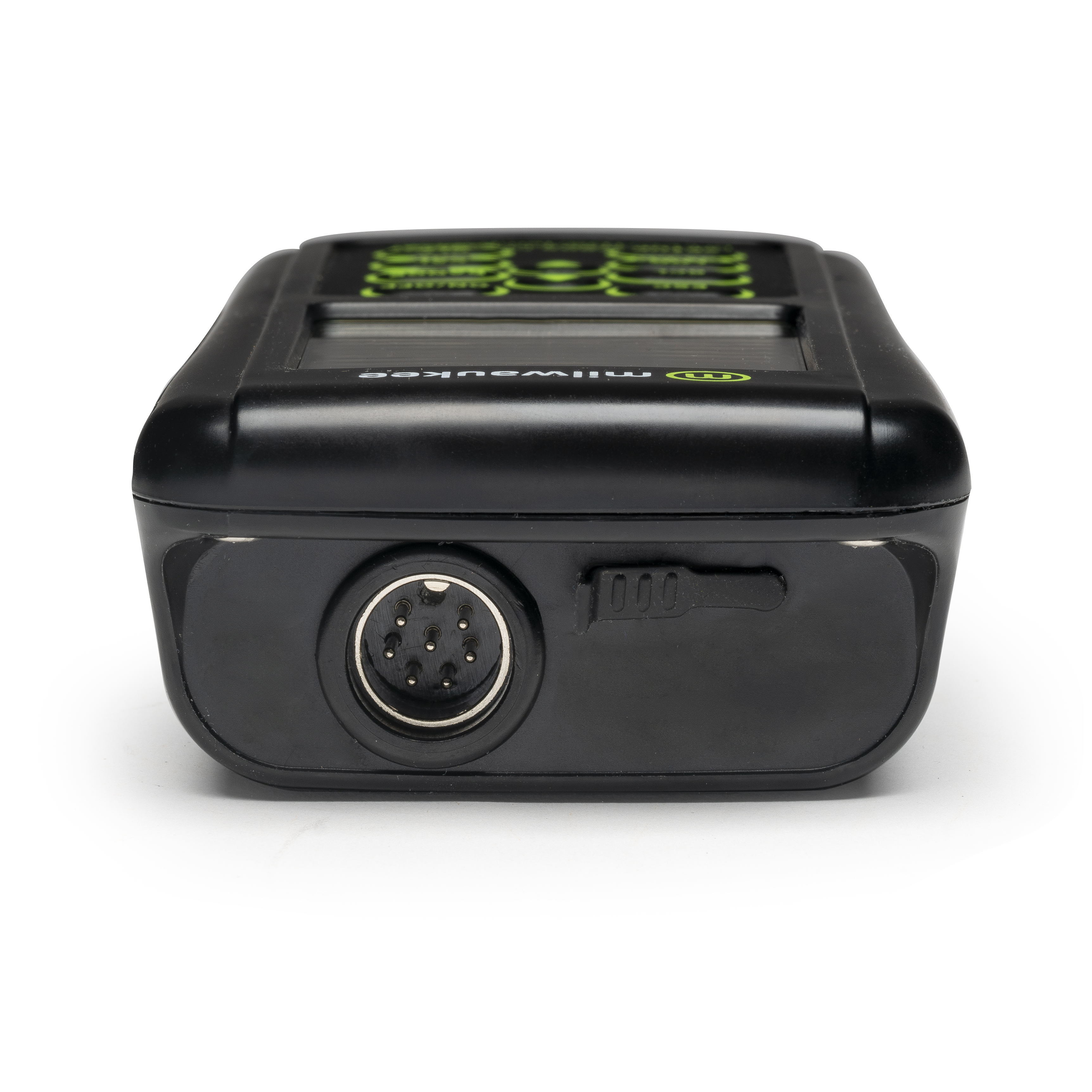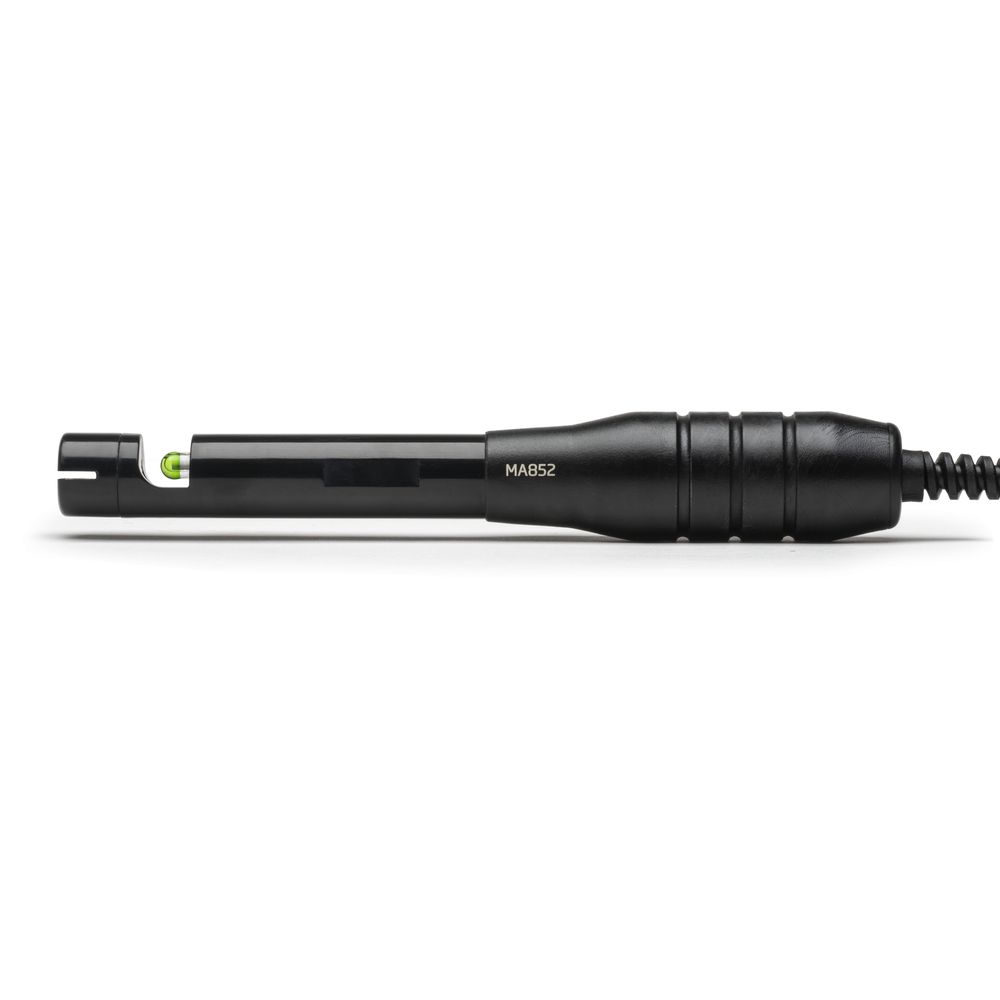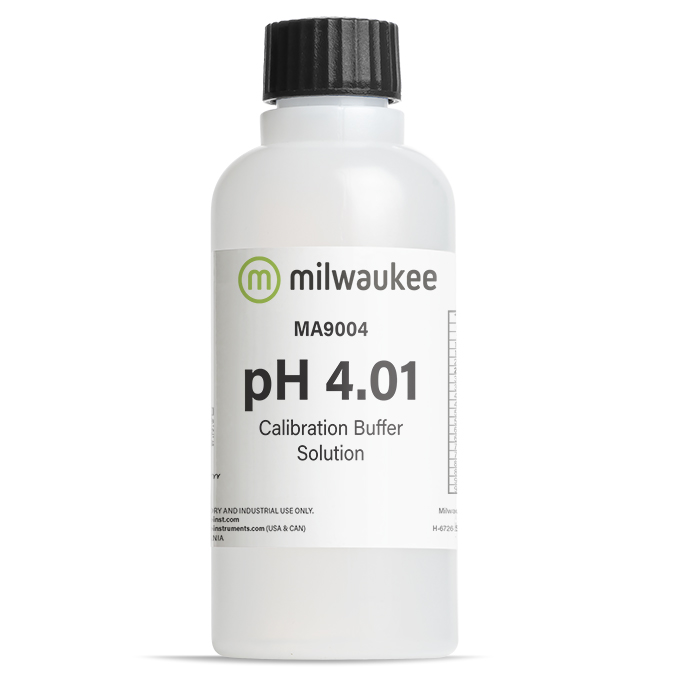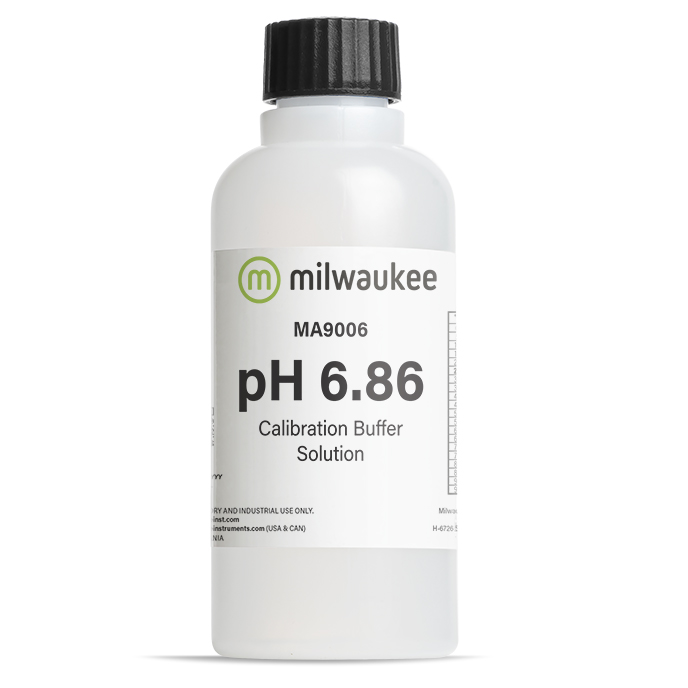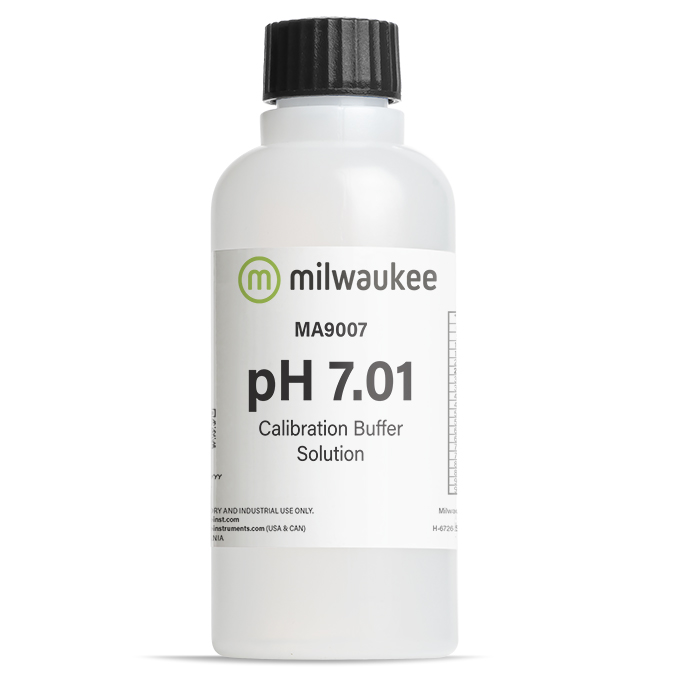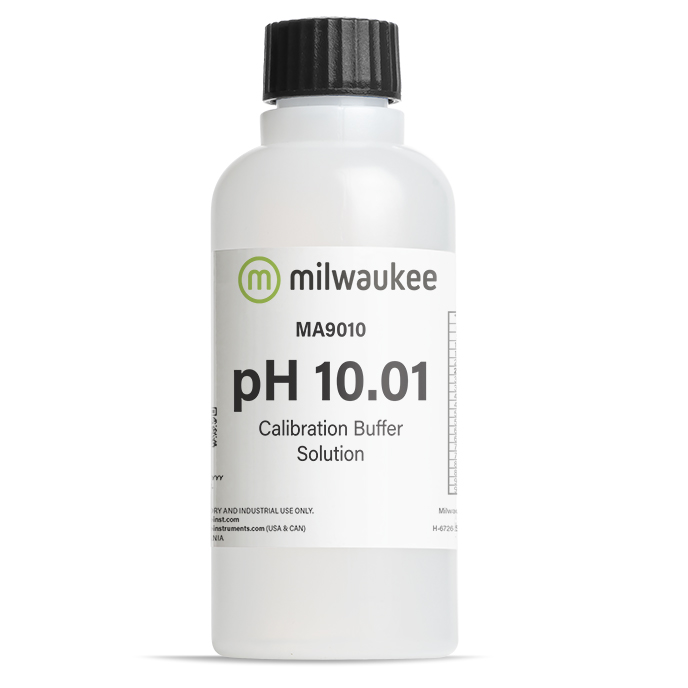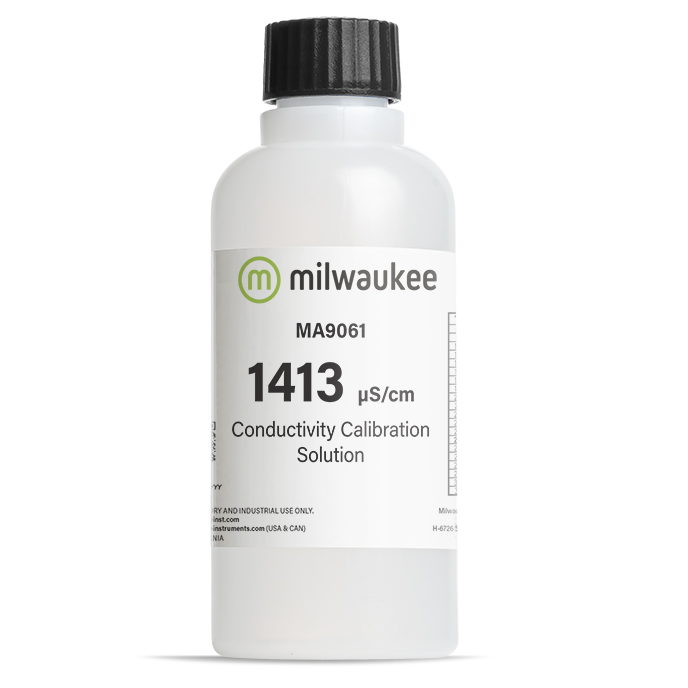Your shopping cart is currently empty.
Milwaukee MW805 PRO pH/EC/TDS/Temp Combo Meter – Portable Accuracy for Water Quality Testing
When precision and reliability matter, the Milwaukee MW805 PRO is ready to deliver. Built for growers, aquarists, field researchers, and water professionals, this all-in-one handheld meter combines pH, electrical conductivity (EC), total dissolved solids (TDS), and temperature into one rugged, easy-to-use instrument. Whether you are fine-tuning nutrient solutions in a hydroponic greenhouse, monitoring aquaculture systems, or verifying water quality on-site, the MW805 PRO is designed to simplify your workflow with accurate results at your fingertips.
With its IP67 waterproof housing, replaceable double-junction pH electrode, and automatic temperature compensation (ATC), the MW805 PRO ensures reliable measurements even in demanding environments. The compact design and built-in logging capability make it equally at home in the lab or in the field, giving you the confidence to test, record, and act quickly – without compromise.
Why Choose the Milwaukee MW805 PRO?
- 4-in-1 Measurement: Simultaneously test pH, EC, TDS, and temperature with one portable device.
- High Accuracy: Achieve precise readings with ±0.05 pH accuracy and ±2% full-scale EC/TDS accuracy.
- Automatic Calibration: Simple one- or two-point auto calibration for pH and one-point calibration for EC/TDS keeps measurements consistent.
- Replaceable Cloth Junction Electrode: Extends probe life and maintains accuracy, especially in fertilizer or nutrient solutions.
- Waterproof & Durable: IP67-rated housing ensures reliability in field and greenhouse conditions.
- Data Logging with GLP: Store and recall up to 1000 data points with date and time for traceability and compliance.
- Long Battery Life: Operates for up to 250 hours on standard batteries, making it dependable for extended use.
- Easy to Use: Backlit LCD display, intuitive menu, and compact design for portability.
Versatile Applications of MW805
Hydroponics & Horticulture
• Monitoring nutrient solution EC/TDS and pH for optimal plant growth
• Preventing nutrient lockout and deficienciesAgriculture
• Checking irrigation water quality
• Managing soil and fertigation solution pH and conductivityAquariums & Aquaculture (Fish, Koi, Shrimp, Coral)
• Maintaining ideal water parameters for aquatic life health
• Monitoring salinity (via EC/TDS) and pH stabilitySwimming Pools & Spas
• Balancing pH for safe, comfortable water
• Monitoring TDS to ensure clarity and equipment careWater Treatment & Purification
• Verifying pH and TDS of input/output water
• Ensuring compliance with water quality standardsEnvironmental & Field Testing
• On-site testing of lakes, rivers, and groundwater
• Rugged waterproof design ideal for outdoor samplingIndustrial Water Monitoring
• Monitoring cooling towers, boilers, or process water
• Ensuring operational efficiency and corrosion controlFood & Beverage Production
• Testing water quality in food and beverage preparation
• Monitoring cleaning and process waterHomebrewing & Fermentation
• Ensuring correct pH and water quality for consistent brewing resultsEducation & Laboratories
• Teaching and demonstrating water chemistry concepts
• Quick, multi-parameter testing for classroom and research labs
Proper Care & Maintenance
To ensure long-term accuracy and reliability, regular care of your MW805 PRO and its electrode is essential:
- Storage: Always keep the pH probe hydrated in storage solution or calibration buffer. Do not store in tap or distilled water, which can damage sensitivity. Store upright with the cap filled with solution to prevent leakage and drying.
- Cleaning: Rinse the electrode after each use. For solutions with fertilizers, organics, or salts, soak periodically in cleaning solution to prevent buildup and clogging of the junction.
- Calibration: Recalibrate regularly to maintain accuracy, especially after cleaning, long storage, or when moving between sample types.
- Electrode Life: The sensing bulb and reference junction naturally wear over time. Replace the probe when response slows or calibration cannot be maintained.
By following these steps, you’ll extend the life of your instrument and ensure consistent, professional-grade measurements every time.
The Milwaukee MW805 PRO delivers portability, precision, and durability in one complete solution – helping you manage water quality with confidence, wherever your work takes you.
Specifications
Application
Hydroponics & Horticulture
In hydroponic and horticultural systems, water is the lifeline of plants. Since nutrients are delivered directly through water rather than soil, maintaining the right balance of pH and electrical conductivity (EC/TDS) is crucial for plant health and yield. Monitoring nutrient levels (EC/TDS) and pH for optimal
plant growth Preventing nutrient lockout or deficiencies The MW805’s portability, automatic temperature compensation, and high accuracy make it an essential tool for growers who want to protect their investment and achieve consistent, high-quality yields.
How to Use the MW805 in Hydroponics & Horticulture
Agriculture
In modern agriculture, water quality plays a direct role in soil health, nutrient delivery, and ultimately, crop yield. Fertilizers, irrigation practices, and soil amendments all interact with pH and conductivity levels in complex ways. Without regular monitoring, farmers risk inefficient fertilizer use, wasted resources, and lower harvests. Checking irrigation water quality Managing soil and fertigation solution pH and
conductivity From small-scale farms to large commercial operations, the MW805 provides a fast, portable way to verify and adjust growing conditions, protecting crops and maximizing productivity.
How to Use the MW805 in Agriculture1. Prepare the Meter o Calibrate the MW805 using fresh pH and EC calibration solutions. o Rinse the electrode with clean water before testing. 2. Test Irrigation Water o Collect a sample of irrigation water in a clean container. o Immerse the probe in the sample, wait for stabilization, and record pH, EC/TDS, and temperature readings. o Compare results against recommended values for your crop type (e.g., irrigation water EC should often be below 1.5 mS/cm for sensitive crops). 3. Test Fertigation Solutions o Place the probe directly into the fertigation tank or mixing reservoir. o Record pH and EC/TDS to confirm nutrient concentrations are within the target range. o Adjust by adding more nutrients (to raise EC) or diluting with fresh water (to lower EC). For pH, use agricultural acids or bases to bring the solution into the ideal range for your crop (commonly pH 5.5–6.5). 4. Test Soil Extracts (Optional) o Mix soil with distilled water in a 1:2 or 1:5 ratio, depending on the standard method. o Let the mixture settle, then insert the probe into the liquid portion to measure pH and EC. o Use this to track soil salinity buildup or acidification over time. 5. Routine Monitoring o Test irrigation water weekly or whenever sources change. o Check fertigation solutions daily during active growing cycles. o Keep a log of readings to track trends and make data-driven adjustments. 6. After Use o Rinse the electrode with clean water to avoid fertilizer residue buildup. o Store the pH electrode properly in storage solution to maintain sensitivity.
Aquariums & Aquaculture (Fish, Koi, Shrimp, Coral)
In both home aquariums and large-scale aquaculture systems, water quality is directly tied to the health and survival of aquatic life. Fish, shrimp, and corals are highly sensitive to changes in pH and salinity, and even small fluctuations can cause stress, disease, or death. That’s why reliable monitoring of pH and dissolved solids is essential for maintaining a balanced aquatic environment. Maintaining ideal water parameters for aquatic life
health Monitoring salinity (via EC/TDS) and pH stability From ornamental aquariums to professional aquaculture operations, the MW805 helps safeguard aquatic investments by giving users the tools to manage water quality with precision and confidence.
How to Use the MW805 in Aquariums & Aquaculture1. Prepare the Meter o Calibrate the MW805 using fresh pH and EC calibration solutions. o Rinse the electrode in clean water to avoid cross-contamination between tests. 2. Test Aquarium or Pond Water o Collect a water sample in a clean container or place the probe directly in the tank/pond. o Wait for the readings to stabilize and record pH, EC/TDS, and temperature. 3. Interpret the Results o Compare pH readings to the ideal range for your species: § Freshwater fish: typically 6.5–7.5 § Koi ponds: 7.0–8.5 § Shrimp: 6.5–7.5 (species-dependent) § Coral reefs/marine tanks: 8.1–8.4 o Use EC/TDS to track mineral balance or salinity: § Freshwater aquariums: low EC/TDS (50–300 ppm) § Marine/coral tanks: 30–35 ppt salinity (approx. 50,000–55,000 ppm TDS equivalent) 4. Adjust if Necessary o For pH: Use aquarium buffers, conditioners, or water changes to stabilize values. o For salinity: Add marine salt mixes (to increase) or fresh water (to decrease). 5. Routine Monitoring o Test at least weekly for aquariums, or daily in aquaculture operations with high stock density. o Track trends over time with the MW805’s logging feature to spot gradual changes before they become critical. 6. After Use o Rinse the probe with fresh water after every test to avoid buildup of salt or organics. o Store the pH electrode in proper storage solution to maintain long-term accuracy.
Swimming Pools & Spas
Water balance is at the heart of safe and enjoyable swimming. If pool or spa water isn’t properly managed, it can quickly turn into an unsafe environment – irritating eyes and skin, damaging equipment, and even reducing the effectiveness of sanitizers. The MW805 PRO helps homeowners, pool technicians, and spa managers maintain perfect balance by monitoring pH and total dissolved solids (TDS), two of the most important water quality parameters. Balancing pH for safe, comfortable water Monitoring total dissolved solids (TDS) for clarity
and equipment care With its waterproof design, high accuracy, and portability, the MW805 PRO is the perfect tool for keeping pools and spas crystal clear and safe.
How to Use the MW805 in Swimming Pools & Spas1. Prepare the Meter o Calibrate the MW805 using fresh pH and EC calibration solutions. o Rinse the probe in clean water before testing. 2. Test Pool or Spa Water o Collect a sample in a clean container or dip the probe directly into the pool/spa. o Wait a few seconds for the readings to stabilize. o Record pH, EC/TDS, and temperature values. 3. Interpret the Results o pH: Keep between 7.2–7.6 for swimmer comfort and sanitizer effectiveness. o TDS: Pools generally should remain under 1500 ppm above the source water TDS; spas under 2000 ppm. Higher levels may require partial water replacement. 4. Adjust if Necessary o For pH: Add pH increaser (soda ash) if too low, or pH reducer (muriatic acid/dry acid) if too high. o For TDS: Dilute by partially draining and refilling with fresh water. 5. Routine Monitoring o Check pH daily for residential pools/spas and more frequently for commercial facilities. o Check TDS monthly, or whenever water begins to look cloudy or sanitizers seem less effective. 6. After Use o Rinse the probe in clean water to remove chemical residues. o Store the pH electrode in proper storage solution to maintain accuracy.
Food & Beverage Production
Water is the foundation of food and beverage quality. From brewing beer and fermenting wine to preparing soft drinks and dairy products, the chemical composition of water affects not only taste but also safety and consistency. In addition, cleaning and sanitizing processes in food production rely on water with controlled pH and low dissolved solids to ensure hygiene and prevent contamination. Testing water quality in food/beverage preparation Monitoring cleaning and process water Whether in a small craft brewery or a large-scale bottling facility, the MW805 PRO provides fast, portable testing to keep water quality in check – protecting product quality and brand reputation.
How to Use the MW805 in Food & Beverage Production1. Prepare the Meter o Calibrate the MW805 with fresh pH and EC/TDS calibration standards. o Rinse the probe with deionized water to prevent contamination between samples. 2. Test Source Water for Production o Collect a water sample from the incoming supply or treatment system. o Immerse the probe, wait for readings to stabilize, and record pH, EC/TDS, and temperature. o Compare results with target specifications for your product (e.g., brewing water often adjusted to pH 5.2–5.6). 3. Test Process Water o Take samples from mixing tanks, fermentation systems, or production lines. o Confirm that water chemistry aligns with recipe or process requirements. o Adjust as needed (e.g., adding salts or acids to modify mineral balance). 4. Test Cleaning Water (CIP Systems) o Measure pH to verify cleaning agents are at effective levels. o Confirm TDS remains within acceptable limits – excessive buildup may reduce cleaning efficiency. o Use the data to decide when rinses or chemical changes are needed. 5. Routine Monitoring o Test water daily in active production, and more frequently during critical steps like brewing mash-in or fermentation. o Use the MW805’s data logging feature to document results for quality assurance and audits. 6. After Use o Rinse the electrode thoroughly to remove any residues or cleaning chemicals. o Store the pH probe in proper storage solution to maintain accuracy.
Homebrewing & Fermentation
For homebrewers and fermentation enthusiasts, water quality is one of the most overlooked but most important factors in achieving consistent, high-quality results. From beer and cider to kombucha, kefir, or sourdough starters, pH and mineral content affect not only flavor but also fermentation activity and stability. The Milwaukee MW805 PRO gives brewers the confidence to measure and adjust water chemistry with professional-grade accuracy in a portable, easy-to-use device. Ensuring correct pH and water quality for consistent
brewing results Water hardness and mineral levels, measured through EC/TDS, also impact brewing character. Calcium, magnesium, and sulfates all shape flavor, mouthfeel, and stability. By testing and adjusting water before brewing, homebrewers can tailor their water to suit specific beer styles (e.g., soft water for pilsners, mineral-rich water for IPAs) and reproduce their recipes consistently batch after batch.
How to Use the MW805 in Homebrewing & Fermentation1. Prepare the Meter o Calibrate the MW805 with pH (4.01, 7.01) and EC calibration solutions before brewing day. o Rinse the probe in distilled or deionized water before use. 2. Test Brewing Water o Collect a sample of your source water (tap, bottled, or filtered). o Measure pH, EC/TDS, and temperature. o Compare to target brewing water profiles; adjust with brewing salts (gypsum, calcium chloride, etc.) or acid additions if needed. 3. Test Mash pH o After mixing grains with strike water, take a small mash sample. o Cool it to room temperature (20–25 °C / 68–77 °F) for an accurate reading. o Measure pH and adjust with brewing acids (lactic, phosphoric) or baking soda if necessary to reach 5.2–5.6. 4. Test During Fermentation o Take periodic samples from the fermenter to monitor pH drop during active fermentation (yeast typically lowers pH by 0.5–1.0 units). o Stable pH helps confirm healthy fermentation and can indicate when the process is complete. 5. Test Final Product (Optional) o Measure the pH of the finished beer, wine, or kombucha to compare with style benchmarks and ensure stability. 6. Routine Brewing Practice o Keep records of all readings (the MW805’s logging feature helps track batches over time). o Adjust recipes or water profiles based on results to achieve consistency. 7. After Use o Rinse the probe thoroughly to remove sugars, proteins, or yeast residues. o Soak in cleaning solution if buildup is suspected. o Store the pH electrode in storage solution until next use.
Education & Laboratories
In both academic settings and research environments, the ability to measure water quality quickly and accurately is essential. Students learning about chemistry, biology, or environmental science benefit from hands-on demonstrations of pH, electrical conductivity (EC), and total dissolved solids (TDS). In laboratories, researchers and technicians need reliable data to support experiments, product testing, or quality control. The Milwaukee MW805 PRO is designed to bridge both needs – simple enough for teaching, yet precise and durable enough for professional lab use. Teaching and demonstrating water chemistry concepts Quick, multi-parameter testing for classroom or
research labs From classrooms to cutting-edge labs, the MW805 PRO brings precision, portability, and simplicity together – helping both students and professionals better understand and manage water chemistry.
How to Use the MW805 in Education & Laboratories1. Prepare the Meter o Calibrate with fresh pH and EC/TDS solutions before starting lessons or experiments. o Demonstrate calibration to students so they understand the importance of accuracy. 2. Teaching Demonstrations o Show students how different water samples (tap, distilled, saltwater, acidic solutions) produce different readings. o Use the MW805 to illustrate how adding chemicals (e.g., acids, bases, salts) changes pH, EC, and TDS in real time. 3. Classroom Experiments o Assign small groups to measure water samples from different sources (school tap, bottled water, pond/lake water). o Have them compare results, analyze trends, and discuss environmental or health implications. 4. Research or Lab Work o Use the MW805 for quick checks of solution pH and conductivity in experiments. o Record values with the built-in logging feature to ensure traceable, reproducible data. o Apply results in areas such as plant science (nutrient solutions), microbiology (growth media), or food research (process water). 5. Routine Monitoring in Labs o Test control samples regularly to verify water quality used in experiments. o Document results for quality assurance, lab reports, or publications. 6. After Use o Rinse the probe with distilled water between different samples to prevent cross-contamination. o Store the electrode in storage solution when finished, ready for the next class or experiment.
Environmental & Field Testing
Water quality monitoring in natural environments is essential for understanding ecosystem health, detecting pollution, and managing resources. Researchers, inspectors, and environmental agencies need tools that can provide quick, accurate data in the field, often under tough conditions. The Milwaukee MW805 PRO is designed for exactly this role, with its waterproof housing, robust electrode design, and ability to measure multiple key parameters (pH, EC, TDS, and temperature) in a single portable device. On-site testing of lakes, rivers, and groundwater Field-ready with waterproof housing and
multi-parameter measurement Whether for academic research, environmental compliance, or water resource management, the MW805 provides a reliable companion for field testing campaigns.
How to Use the MW805 in Environmental & Field Testing1. Prepare the Meter Before Fieldwork o Fully calibrate the MW805 using fresh pH and EC/TDS calibration solutions. o Pack calibration solutions, cleaning solution, and storage solution if multiple field measurements are planned. o Ensure the batteries are fresh to take advantage of the long operating life (up to 250 hours). 2. Collect Samples or Test In Situ o For streams, lakes, or ponds: you can dip the probe directly into the water body. o For groundwater or remote locations: collect samples in clean containers and measure immediately to prevent parameter drift. 3. Take Readings o Submerge the probe and wait for stabilization. o Record pH, EC, TDS, and temperature readings from the backlit LCD. o Use the logging function to store data with time/date stamps for later analysis. 4. Interpret Results o Compare readings to environmental benchmarks: § Healthy freshwater ecosystems often have pH between 6.5–8.5. § Elevated EC/TDS may signal agricultural runoff, salinity intrusion, or industrial discharge. § Temperature data helps identify thermal pollution or seasonal patterns. o Use the data to identify abnormal conditions, track trends, or flag areas for deeper laboratory testing. 5. Routine Monitoring & Surveys o Repeat measurements at regular intervals to build a time series. o Take multiple readings along a river, stream, or watershed for a complete profile. o Export or manually record logged data for environmental reports. 6. After Fieldwork o Rinse the probe thoroughly with clean water after each site to prevent cross-contamination. o Soak the electrode in cleaning solution if samples contained organics, sediments, or algae. o Store the electrode in storage solution after the final measurement.
Water Treatment & Purification
In water treatment and purification processes, accurate testing is the key to ensuring both safety and compliance. Whether you are managing municipal systems, industrial treatment plants, or small-scale purification units, the ability to verify pH and total dissolved solids (TDS) at multiple points in the process helps maintain efficiency and protect public health. Verifying pH and TDS of input/output water Ensuring compliance with water quality standards From municipal facilities to small purification systems, the MW805 provides fast, portable, and reliable verification of water quality parameters at every stage of treatment.
How to Use the MW805 in Water Treatment & Purification1. Prepare the Meter o Calibrate the MW805 using fresh pH and EC/TDS calibration standards. o Rinse the probe with clean water to avoid contamination between samples. 2. Test Raw/Incoming Water o Collect a water sample before it enters the treatment system. o Immerse the probe, wait for stabilization, and record pH, TDS, and temperature. o Use this data to identify treatment requirements (e.g., adjusting chemical dosing, confirming filtration needs). 3. Test Treated/Output Water o After purification, test the output water the same way. o Compare values against target specifications and regulatory standards: § Drinking water: pH typically between 6.5–8.5; TDS < 500 ppm (WHO guideline). § RO-treated water: very low TDS (< 50 ppm) with neutral pH. § Industrial water: ranges vary depending on application, but stability is key. 4. Routine Monitoring o Test input and output water daily in critical systems, or as required by regulations. o For continuous operations, test at multiple points along the system (pre-treatment, post-treatment, distribution). o Use the MW805’s data logging feature to store results for compliance records. 5. Adjust if Necessary o Correct pH imbalances by adjusting chemical dosing (acids, bases, or neutralizing agents). o High TDS in output water may indicate filter saturation, RO membrane failure, or contamination – requiring system maintenance or water replacement. 6. After Use o Rinse the electrode thoroughly to remove any treatment chemicals or residues. o Store the pH probe in storage solution to preserve sensitivity.
Industrial Water Monitoring
In industrial facilities, water is not just a utility – it’s a critical part of production, cooling, and safety systems. From boilers and cooling towers to process water loops, the quality of water directly impacts efficiency, equipment lifespan, and regulatory compliance. The Milwaukee MW805 PRO helps operators and technicians track essential water parameters, ensuring stable operation and preventing costly downtime. Monitoring cooling towers, boilers, or process water Ensuring efficiency, corrosion control, and safety In short, reliable monitoring helps industries save money, conserve resources, and protect their infrastructure.
How to Use the MW805 in Industrial Water Monitoring1. Prepare the Meter o Calibrate the MW805 with standard pH and EC calibration solutions before field use. o Rinse the probe with deionized water to remove residues from previous samples. 2. Test Cooling Tower Water o Collect a sample from the tower basin or sampling port. o Immerse the probe, wait for readings to stabilize, and record pH, EC/TDS, and temperature. o Compare values to system guidelines (e.g., EC thresholds for blowdown cycles, pH typically 7.0–9.0 depending on treatment strategy). 3. Test Boiler Feed or Boiler Water o Sample from the feedwater line or boiler blowdown. o Record readings carefully – boiler systems often require strict limits to prevent corrosion and scaling. o Typical targets: neutral pH (8.5–9.5 in many systems) and low conductivity for high-pressure boilers. 4. Test Process Water o Take samples from production lines, rinsing systems, or storage tanks. o Check pH and TDS against required specifications (e.g., food & beverage facilities may demand very low TDS and stable pH). 5. Interpret and Adjust o High EC/TDS: May require dilution, blowdown, or increased treatment dosing. o Low or high pH: Adjust with acid/base dosing systems as per plant standards. o Temperature data: Track to ensure efficient heat transfer and system safety. 6. Routine Monitoring o Test daily (or more often in critical systems). o Use the MW805’s GLP data logging to store results with timestamps for trend analysis and compliance reporting. 7. After Use o Rinse the electrode with clean water to remove treatment chemicals. o Store the pH probe in storage solution to maintain long-term accuracy.
|



